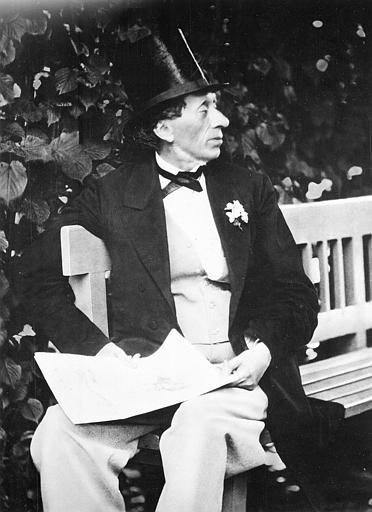Wednesday, May 6, 2015
The fairy-tale writer who never got his own happily ever after
His stories are known throughout the world and several of them have even been further popularized by Disney and Pixar. When fairy-tales are mentioned, it is either his name or the Brothers Grimm that come to mind, and yet, while one might imagine that a man like Hans Christian Andersen would have married for love and lived happily ever after, the truth is that he never experienced the great romance that he always dreamed of.
Born in Odense, Denmark, in 1805 to a father who worked as a shoemaker and a mother who worked as a washerwoman, his family was quite poor. Even so, it was Andersen's father who introduced Andersen to literature by reading the Arabian Nights to him. But after Andersen's father died in 1816, following an illness that he contracted during the Napoleonic Wars (which he enlisted to fight in from 1812-1814), and Andersen's mother re-married, Andersen left for Copenhagen to try his luck at the Royal Theater. Apparently, he had a great soprano voice, but this quickly changed as he entered pubity. Determined to gain a foothold within the theater in spite of this setback, Andersen wrote a number of plays, all of which were rejected.
To soften the blow, however, the director of the Royal Danish Theater, Jonas Collin, who'd developed a fondness for Andersen, became his benefactor and arranged for him to attend grammar school, persuading King Frederik VI to pay part of the education. Unfortunately, Andersen ended up living at the school principal's house - a man who did not hesitate to mistreat Andersen in order to "improve upon his character." It was during this time - one that Andersen later described as the darkest and most bitter of his life - that he wrote his famous poem The Dying Child. At this point, I would like to mention that many of Andersen's works, including a large number of his fairy tales, were tragic in nature. Examples include The Little Mermaid, but I'll delve into that with another post later.
After complaining to Collin about his situation, Andersen was taken out of school and privately tutored in Copenhagen. Since he was born with dyslexia, Andersen never learned to spell properly and his writing was filled with mistakes. In some ways, this may have been a blessing in disguise since his writing style remained close to the spoken language and therefore sounds fresh, even today.
After passing his exams in 1827, Andersen made his debut as a writer in 1829 with his short story titled, A Journey on Foot from Holmen's Canal to the East Point of Amager. It was an immediate success. By comparison, his first collection of fairy tales, which consisted of nine stories, including The Tinderbox, The Princess and the Pea, Thumbelina, The Little Mermaid and The Emperor's New Clothes sold poorly. His fairy tale collection didn't gain popularity until 1845, when it was translated into English and The Athenæum, a literary London Journal reviewed it, saying: "This is a book full of life and fancy; a book for grandfathers no less than grandchildren, not a word of which will be skipped by those who have it once in hand."
During the course of his life, Andersen fell in love with four notable women: Riborg Voigt, Sophie Ørsted, Louise Collin and Jenny Lind. Of these, Riborg and Jenny probably had the most profound effects on Andersen. Jenny was a Swedish opera singer whom Anderson encouraged. He gave her the confidence she needed to perform abroad, which in turn made her one of the most successful opera singers of her day. It is believed that he wrote The Nightingale in honor of her, but when he professed his love for her, she claimed that she only thought of him as a brother.
Riborg, on the other hand, is perhaps the most tragic of Andersen's love interests. She was the sister of his friend, Christian Voigt, and when Andersen went to pay Christian a visit one time, it was Riborg who opened the door. The two engaged in conversation and while it is certain that he fell for her, it is also believed that she reciprocated his feelings. Unfortunately, she was already engaged to someone else, and as you may know, it would have been scandalous for her to call off her engagement during the time period in which they were living. Years later, upon Andersen's death in 1875, a pouch was discovered at his chest, carrying a letter from Riborg. Likewise, a secret drawer in Riborg's bureau was later found to contain Andersen's poems, a bouquet of flowers from him and a photo.
Monday, May 4, 2015
Modern princes and princesses - the real fairytale stories. Part 2
I initially planned for a more involved post for the second installment of modern princes and princesses, but since the British royal family has just been blessed with a new member, I've decided that this post should center around Prince William and Princess Kate, the Duke and Duchess of Cambridge.
I'm not sure many other royal families have gained as much notoriety over the past thirty four years as the British one has, ever since Diana Spencer said 'yes' to Prince Charles. A turbulent time awaited the House of Windsor back then, and while I'm not sure how talked about they were in the US during the 80's and 90's, I can assure you that they were the center of many lively debates on the other side of the 'pond.'
But while most of the talk before was based on scandal, it seems to have taken a turn for the better, which is unquestionably due to Prince William and Princess Kate, who seem to have single handedly saved the British Monarchy with their elegance, their 'normalcy', their obvious love for each other and the joy with which they're bringing their children into the world and offering them the chance to be 'just like everyone else', without the pretense that comes with their station. I think children need this - the ability to hug their parents in public without being told that they should stand up straight instead. So good for Prince William and Princess Kate! They've fought their share of battles already against the strictures and traditions that other members of the royal family (you know who) wish to impose upon them. I hope they'll continue to do so in the years to come, for the sake of each other, their children and their country, whom they represent so wonderfully well.
I'm not sure many other royal families have gained as much notoriety over the past thirty four years as the British one has, ever since Diana Spencer said 'yes' to Prince Charles. A turbulent time awaited the House of Windsor back then, and while I'm not sure how talked about they were in the US during the 80's and 90's, I can assure you that they were the center of many lively debates on the other side of the 'pond.'
But while most of the talk before was based on scandal, it seems to have taken a turn for the better, which is unquestionably due to Prince William and Princess Kate, who seem to have single handedly saved the British Monarchy with their elegance, their 'normalcy', their obvious love for each other and the joy with which they're bringing their children into the world and offering them the chance to be 'just like everyone else', without the pretense that comes with their station. I think children need this - the ability to hug their parents in public without being told that they should stand up straight instead. So good for Prince William and Princess Kate! They've fought their share of battles already against the strictures and traditions that other members of the royal family (you know who) wish to impose upon them. I hope they'll continue to do so in the years to come, for the sake of each other, their children and their country, whom they represent so wonderfully well.
 |
| 2011 |
 | |||
| With Prince George, born July 22nd, 2013 |
 |
| Born, May 2nd, 2015, the new princess' name will remain unknown until the Christening |
Subscribe to:
Posts (Atom)


